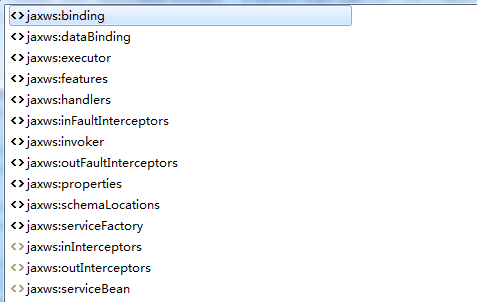CXF:基于JAX-WS的webservice
本文主要涉及的webservice采用SOAP协议、采用JAX-WS作为前端、JAXB数据绑定。需要加入以下依赖:
<dependency> <groupId>org.apache.cxf</groupId> <artifactId>cxf-rt-frontend-jaxws</artifactId> <version>2.7.0</version> </dependency> <dependency> <groupId>org.apache.cxf</groupId> <artifactId>cxf-rt-bindings-soap</artifactId> <version>2.7.0</version> </dependency> <dependency> <groupId>org.apache.cxf</groupId> <artifactId>cxf-rt-databinding-jaxb</artifactId> <version>2.7.0</version> </dependency> <dependency> <groupId>org.apache.cxf</groupId> <artifactId>cxf-rt-transports-http</artifactId> <version>2.7.0</version> </dependency>
1、server端
与之前基于JAX-WS的webservice一致,作为前端并不需要有任何修改。在这个例子中包含了传递String、自定义对象、Map等
@WebService(serviceName = "cxfServer")
public class CXFServiceImpl implements CXFService {
@Override
@WebMethod
public String sayHello(String name) {
return "Hello, " + name + ", from CXF";
}
@Override
@WebMethod
@WebResult
@XmlJavaTypeAdapter(value = MapAdapter.class)
public Map<String, Person> queryPerson() {
Map<String, Person> map = new HashMap<String, Person>();
map.put("p1", new Person("robin", "robin_123"));
map.put("p2", new Person("ace", "ace_456"));
return map;
}
@Override
@WebMethod
public void savePerson(@WebParam List<Person> list) {
if (list != null && !list.isEmpty()) {
for (Person person : list) {
System.out.println(ToStringBuilder.reflectionToString(person, ToStringStyle.SHORT_PREFIX_STYLE));
}
}
}
}
注意对传递Map,在JAX-WS是不能直接传递,需要作为一个包装类传递。而在CXF中则可以直接传递,这里还是采用JAXB作为解析对象故这里的MapAdapter与之前的一致.见这里
2、发布为一个webservice
1、jaxwsserver
JaxWsServerFactoryBean factory = new JaxWsServerFactoryBean();
factory.setServiceClass(CXFServiceImpl.class);
factory.setAddress("http://localhost:8080/service/helloCxfService");
//optional: set in interceptors
factory.getInInterceptors().add(new LoggingInInterceptor());
//optional: set out interceptors
factory.getOutInterceptors().add(new LoggingOutInterceptor());
factory.create();
由于采用jetty作为默认的Server的实现,需要加入
<dependency> <groupId>org.apache.cxf</groupId> <artifactId>cxf-rt-transports-http-jetty</artifactId> <version>2.7.0</version> </dependency>
运行后即可通过http://localhost:8080/service/helloCxfService?wsdl查看发布结果。或者可以通过这样测试
JaxWsProxyFactoryBean factory = new JaxWsProxyFactoryBean();
factory.setServiceClass(CXFService.class);
factory.setAddress("http://localhost:8080/service/helloCxfService");
CXFService server = (CXFService) factory.create();
2、spring集成的几种方式
需要在spring的配置文件加入相应的schema及location:
xmlns:jaxws="http://cxf.apache.org/jaxws" http://cxf.apache.org/jaxws http://cxf.apache.org/schemas/jaxws.xsd <import resource="classpath:META-INF/cxf/cxf.xml" /> <import resource="classpath:META-INF/cxf/cxf-extension-soap.xml" /> <import resource="classpath:META-INF/cxf/cxf-servlet.xml" />
打开位于cxf-rt-frontend-jaxws-2.7.0.jar/schemas/jaxws.xsd文件,我们查看定义了三种方式:
jaxws:endpoint jaxws:server jaxws:client
前两者用来申明发布server,后者作为客户端的配置。下面来看看与spring继承的几种方式:
1、采用jaxws:server配置
<!-- 采用jaxws:server方式 --> <jaxws:server id="helloCxf" serviceClass="org.ws.server.cxf.chap1.CXFService" address="http://localhost:8080/service/helloCxf"> <jaxws:serviceBean> <bean class="org.ws.server.cxf.chap1.impl.CXFServiceImpl" /> </jaxws:serviceBean> <jaxws:inInterceptors> <bean class="org.apache.cxf.interceptor.LoggingInInterceptor" /> </jaxws:inInterceptors> <jaxws:outInterceptors> <bean class="org.apache.cxf.interceptor.LoggingOutInterceptor" /> </jaxws:outInterceptors> </jaxws:server>这里jaxws:endpoint的配置大同小异,具体参数配置见jaxws.xsd
2、由于采用JAX-WS作为前端,作为对JaxWsServerFactoryBean实例的注入:
<!-- 作为对JaxWsServerFactoryBean的注入 --> <bean id="cxfServiceFactory" class="org.apache.cxf.jaxws.JaxWsServerFactoryBean"> <property name="serviceClass" value="org.ws.server.cxf.chap1.impl.CXFServiceImpl" /> <property name="address" value="http://localhost:8080/service/helloCxf" /> <property name="inInterceptors"> <list> <bean class="org.apache.cxf.interceptor.LoggingInInterceptor" /> </list> </property> <property name="outInterceptors"> <list> <bean class="org.apache.cxf.interceptor.LoggingOutInterceptor" /> </list> </property> </bean>
针对上面两种配置,可以通过在http://localhost:8080/service/helloCxf?wsdl访问发布成功与否。当然上面的address采用了绝对路径,实际上和web项目的整合只需要指定到相对路径即可。<bean id="helloCxfService" class="org.ws.server.cxf.chap1.impl.CXFServiceImpl"
factory-bean="cxfServiceFactory" factory-method="create" />
3、与web项目(tomcat)
还是采用上面第二种配置,这里只需要修改address的路径如:
<property name="address" value="/helloCxf" />
在web.xml中需要添加一个servlet对请求的拦截处理,如:
<servlet> <servlet-name>CXFServlet</servlet-name> <servlet-class>org.apache.cxf.transport.servlet.CXFServlet</servlet-class> <load-on-startup>1</load-on-startup> </servlet> <servlet-mapping> <servlet-name>CXFServlet</servlet-name> <url-pattern>/service/*</url-pattern> </servlet-mapping>运行后即可通过容器发布的路径访问,如:http://localhost:8080/webservice/service/helloCxf?wsdl
3、客户端访问
以上都是讲述的服务端的实现,如何发布一个服务。在上面的各种服务都是基于SOAP协议,用户可以获得生产的wsdl文件,来生产相应的客户端代码来完成远程的调用。在前面介绍JAX-WS的时候讲解了两种工具来生产客户端代码:wsimport/wsgen。而CXF也同样提供了类似的一些列工具,这里正对这种场景我们需要用到的是wsdl2java,位于CXF_HOME/bin目录
可以通过wsdl2java -help来看具体的参数,这里生产一个客户端代码如下:
wsdl2java -p org.sample.ws.client.cxf.chap1 -keep -verbose http://localhost:8080/webservice/service/helloCxf?wsdl
这样在指定的包下就生产了客户端代码。下面通过spring配置类测试客户端的调用,与上面发布服务一样,通过两种方式:
1、作为jaxws:client调用:
<jaxws:client id="helloCxfClient" address="http://localhost:8080/webservice/service/helloCxf" serviceClass="org.sample.ws.client.cxf.chap1.CXFService"> <jaxws:inInterceptors> <bean class="org.apache.cxf.interceptor.LoggingInInterceptor" /> </jaxws:inInterceptors> <jaxws:outInterceptors> <bean class="org.apache.cxf.interceptor.LoggingOutInterceptor" /> </jaxws:outInterceptors> </jaxws:client>
这里需要注意哪些配置是作为element哪些是attribute
2、作为对JaxWsProxyFactoryBean注入的实现:
<!-- 作为对JaxWsProxyFactoryBean的注入 --> <bean id="cxfClientFactory" class="org.apache.cxf.jaxws.JaxWsProxyFactoryBean"> <property name="serviceClass" value="org.sample.ws.client.cxf.chap1.CXFService" /> <property name="address" value="http://localhost:8080/webservice/service/helloCxf" /> <property name="inInterceptors"> <list> <bean class="org.apache.cxf.interceptor.LoggingInInterceptor" /> </list> </property> <property name="outInterceptors"> <list> <bean class="org.apache.cxf.interceptor.LoggingOutInterceptor" /> </list> </property> </bean> <bean id="helloCxfService" class="org.sample.ws.client.cxf.chap1.CXFService" factory-bean="cxfClientFactory" factory-method="create" />
客户端测试代码:
ClassPathXmlApplicationContext xmlApplication = new ClassPathXmlApplicationContext("cxf-spring.xml");
CXFService service = (CXFService) xmlApplication.getBean("helloCxfService");
System.out.println(service.sayHello("robin"));
4、异步
由于采用JAX-WS作为前端,针对之前在用JAX-WS发布异步服务,我们这里也可以采用相同的方式:
编写binding.xml文件,指定异步方式:
<bindings xmlns:xsd="http://www.w3.org/2001/XMLSchema" xmlns:wsdl="http://schemas.xmlsoap.org/wsdl/" wsdlLocation="http://localhost:8080/webservice/service/helloCxf?wsdl" xmlns="http://java.sun.com/xml/ns/jaxws"> <bindings node="wsdl:definitions"> <enableAsyncMapping>true</enableAsyncMapping> </bindings> </bindings>在生成客户端的时候需要指定该binding.xml文件
wsdl2java -p org.sample.ws.client.cxf.chap2 -b .\binding.xml -keep -verbose http://localhost:8080/webservice/service/helloCxf?wsdl测试:
JaxWsProxyFactoryBean factory = new JaxWsProxyFactoryBean();
factory.setServiceClass(CXFService.class);
factory.setAddress("http://localhost:8080/webservice/service/helloCxf");
CXFService server = (CXFService) factory.create();
System.out.println("同步--> server.sayHello(\"robin\"): " + server.sayHello("robin"));
Response<SayHelloResponse> response = server.sayHelloAsync("robin");
while (!response.isDone()) {
System.out.println("异步调用......");
}
System.out.println("异步: " + response.get().getReturn());

